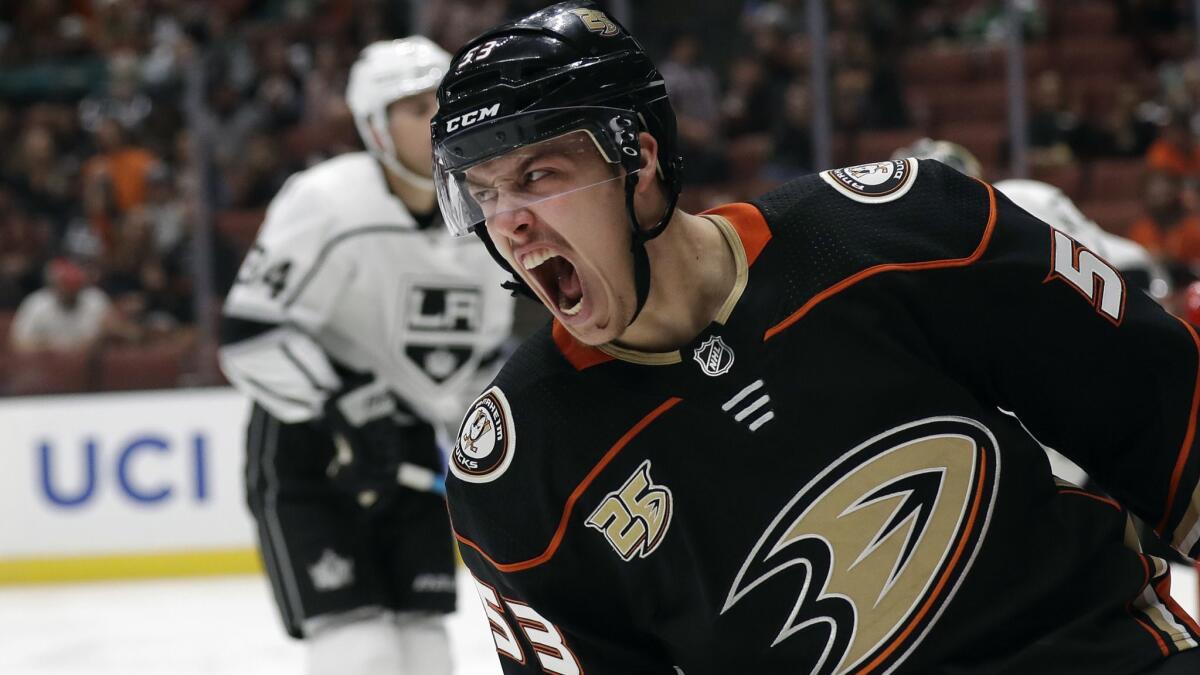Ducks ready for first test of younger, swifter lineup
- Share via
Reporting from San Jose — The Ducks will begin the 2018-19 season where their previous season ended, in San Jose’s SAP Center, but only the venue will be the same.
The Ducks’ lineup against the Sharks on Wednesday night will feature at least five rookies, according to coach Randy Carlyle, and it will embody the significant philosophical and strategic changes the Ducks were forced to make over the summer after they were swept out of the playoffs by the Sharks last spring.
Rookie forwards Troy Terry, Max Comtois, Sam Steel and Kiefer Sherwood were poised to play in the Ducks’ season opener, each on a different line. Also expected to play was defenseman Marcus Pettersson, who played in 22 regular-season games and four playoff games last season and is still classified as a rookie. Terry played two games with the Ducks last season but Comtois, Steel and Sherwood were preparing to make their NHL debut. Center Isac Lundestrom, the Ducks’ 2018 first-round draft pick, remains with the team, but in the morning skate he was aligned with Ryan Kesler, who won’t play, and with Brian Gibbons, who wasn’t expected to play.
The number of youngsters in the Ducks’ lineup would be smaller without the physical problems experienced by Kesler (arthritic hip), Patrick Eaves (shoulder surgery), Ondrej Kase (concussion) and Corey Perry (knee surgery), and the lack of a contract agreement with restricted free agent forward Nick Ritchie. But the Ducks were headed in the direction of becoming younger and swifter anyway. The absence of those forwards accelerated the changeover.
“I’m excited about our lineup. I think the guys have been playing great. Lots of energy, those kinds of things,” said team captain Ryan Getzlaf, who skated alongside Rickard Rakell and Terry in the morning skate. “There will be bumps along the way. We’re all aware of that. But as long as we can play a good team game we can protect those mistakes and make sure that we’re all pushing in the same direction.
“I think we’ve done a good job buying in so far to what we want to accomplish. The real tests are now. The preseason is what it is. It’s all scrambly and you’re not seeing everybody else’s best lineups, either. It’s just a matter of our team buying into the system that we want to play right now and continue doing that.”

The Ducks finished their preseason schedule with three straight wins, including back-to-back decisions over the Kings. Training camp was actually useful for them, instead of a few weeks of waiting and trudging through meaningless games.
“I think we’ve had a way more, it seemed like energetic camp and more of an atmosphere that I think was what we needed, to be honest, from last year,” said winger Andrew Cogliano, who joined waiver pickup Pontus Aberg in flanking Steel. “It’s been great. We’ve done all the right things, I think, in camp. We’ve taken all the right steps. Now it’s actually playing and putting that to work and there’s no better team and no better place to do that. This is a tough building and as tough a team as you’re going to find in the league. We’ll see where we’re at right now.”
Cogliano also praised Carlyle for changing the preseason routine. “I think Randy did a really good job of doing things we hadn’t done before, which I think was refreshing,” Cogliano said. “I thought he handled the camp really good and I thought we got a lot out of it. I thought we started to change our game in terms of how we needed to play.”
The Sharks held their morning skate at their practice facility. New acquisition Erik Karlsson, a two-time winner of the Norris trophy as the NHL’s top defenseman, is scheduled to make his Sharks debut on Wednesday.
Carlyle said the Ducks’ swift playoff loss to San Jose last spring wasn’t the only reason the team has gone to youth and to an up-tempo game, but both moves clearly were necessary in a league that is putting an increased premium on speed. “We did not and couldn’t create the energy that was required and they played it to a higher level. The changes that we’ve made and the direction in which we’re going is what the rest of the league has got,” Carlyle said. “We’ve brought in some younger players — forced to bring in some younger players through injury — but we decidedly as an organization made a decision that we were going to have to trend our game to a speed game, and that’s what we’ve done.”
Soon they’ll find out how successful those changes have been.
More to Read
Go beyond the scoreboard
Get the latest on L.A.'s teams in the daily Sports Report newsletter.
You may occasionally receive promotional content from the Los Angeles Times.






